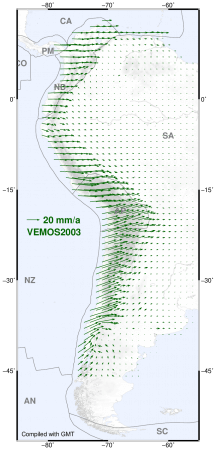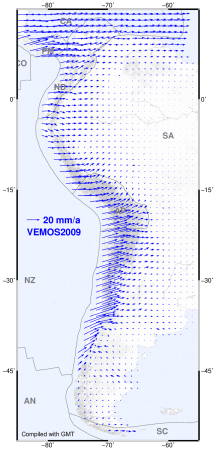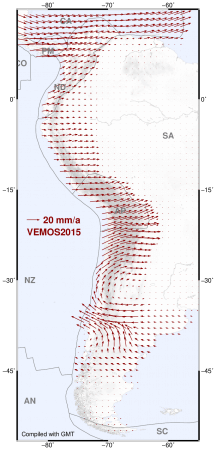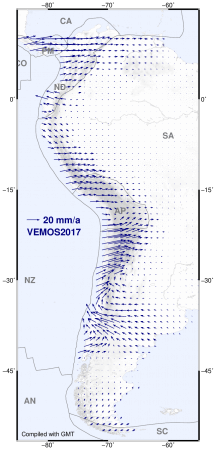Surface Deformation
Models
Why is the Earth’s surface in constant change?
Effects of ongoing geodynamic processes may be inferred from crustal movements detected by the analysis of repeated (or continuous) geodetic observations. The basic concept is to determine and compare the geometry of a network formed by the geodetic stations at certain epochs. The changes of the network geometry over large time spans (e.g. years) are interpreted as a deformation of the network caused by geodynamic processes underlying the studied area.
To ensure a high reliability in the determination of the network geometry, the geodetic measurements must be processed over the entire time span following strict standards and procedures. The existing geodetic space techniques allow the determination of station positions and velocities with accuracies at the millimetre and the sub-millimetre/year level, respectively.
The station velocities in a geodetic network mirror a superposition of a large-scale variation (common to all stations) and a short-scale variation (specific for each station). The large-scale variation usually represents the motion of the tectonic plate underlying the area covered by the geodetic network, while the short-scale variation represents the deviation of the station motions from the plate motion; i.e., a deformation. A surface deformation model is then inferred by interpolating the pointwise short-scale variations to a regular grid. Presently, surface deformations are mainly determined using Global Navigation Satellite Systems (GNSS) positioning and Interferometric Synthetic Aperture Radar (InSAR – mostly vertical deformations) techniques.
Surface deformation models play a main role in geodesy. Geodetic reference frames comprise coordinates of station positions at a certain epoch and constant velocities describing a secular station motion. In active seismic regions, strong earthquakes cause large displacements of station positions and velocity changes disabling the use of such coordinates over any time periods. With the surface deformation models, it is possible to monitor the kinematics of reference frames, to determine transformation parameters between pre-seismic and post-seismic (deformed) coordinates, and to interpolate surface motions arising from plate tectonics or crustal deformations in areas where no geodetic stations are established.
Data Sources
Surface deformation models for geodetic applications are specially needed in regions with strong seismic activity. They are usually provided by the national geodetic agencies. Organisations responsible for the regional densification of the ITRF (International Terrestrial Reference Frame) also provide some regional surface deformation models.







